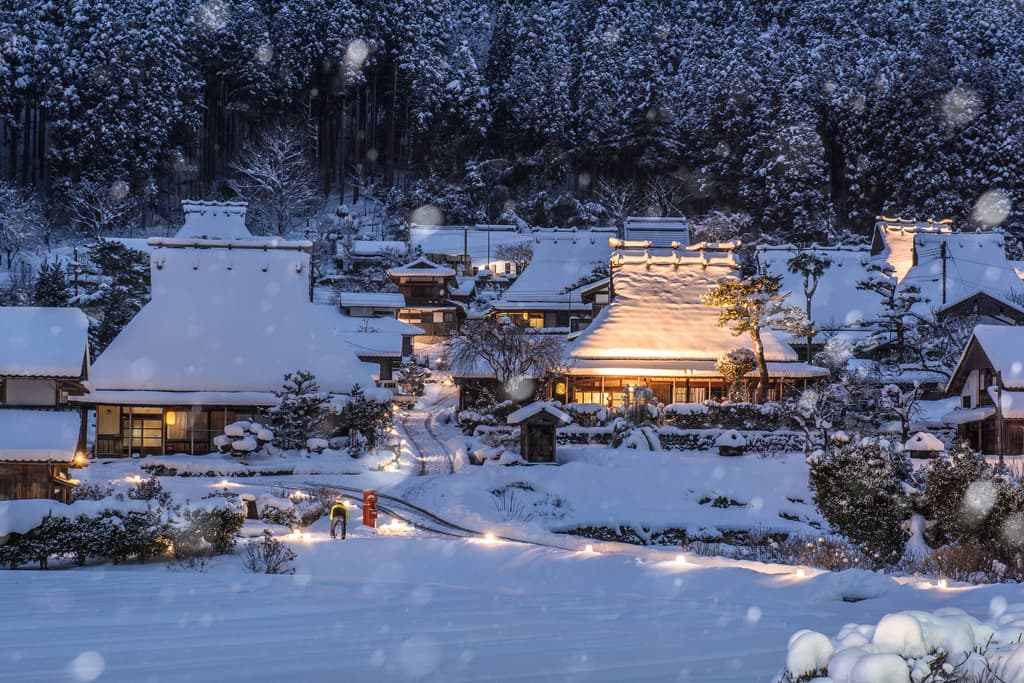Miyama is a Satoyama with a row of houses with thatched roofs, a landscape that still retains the original Japanese landscape. It is a quiet and tranquil place surrounded by beautiful mountains, different from the Kyoto one generally imagines. This area is perfect for those who want to feel the atmosphere of an old Japanese village or hometown.
Miyama-cho is located almost in the center of Kyoto. It takes about 2 hours to get there by public transportation, or about 1.5 hours if you rent a car. If you are planning a long trip to Kyoto, why not visit Miyama to feel the charm of a new Kyoto?
To learn more about Kyoto, click here.
Miyama’s thatched village (Kayabuki no Sato)(かやぶきの里)
This is one of the most popular tourist spots in Miyama-cho. It is a popular spot for visitors to encounter the original landscape of Japan, with many private houses with thatched roofs still in existence.
A thatched roof is a roof made of awn or straw. Although it is a primitive roof construction, it is characterized by its durability, heat retention, and functionality. However, because of its vulnerability to fire, it is now prohibited to build a new house with a thatched roof.
There is also a café, a museum, and a guest house in the village of Kayabuki-no-Sato. Also, a local guide will take you around the village with commentary during the “Thatched Village Guided Walk,” which can be reserved in advance. For details and reservations, please visit the website below.
Also, please visit Kayabuki-no-Sato’s Instagram for information on what is going on in the village and the opening hours of each facility.
Private guided tour of Kayabuki-no-Sato (English): https: //miyamanavi.com/en/activity/detail/englishguidedwalk.html
Official Instagram of Kayabuki-no-Sato: https://www.instagram.com/kayabukinosato_kaisha/
Miyama Folklore Museum(美山民俗資料館)
This museum was built in a farmhouse that was acquired about 200 years ago. Unfortunately, the main house and barn were destroyed by fire in May 2000, but the original architecture has been faithfully restored with reference to the remaining records.
In addition to exhibiting more than 200 pieces of farm equipment and furniture, visitors can also see baths and toilets, allowing them to closely observe the lifestyle of the time. Visitors can also see the attics of the roofs, which are covered with shingles.
Souvenir shop Kaya-no-sato(お土産処 かやの里)
A souvenir store located in Kayabuki-no-Sato. The shop offers a lineup of products made with local ingredients. Especially recommended are rice cakes and dumplings made from locally grown ingredients. Handmade cookies from Cafe Gallery Saika, a café in Kayabuki-no-Sato, also make great souvenirs.
Roadside Station Miyama Fureai Hiroba(道の駅 美山ふれあい広場)
Roadside Station Miyama Fureai Hiroba has the Kyoto Tamba Kogen Quasi-National Park Visitor Center, a tourist information center in Miyama, and Furatto Miyama, which sells local specialty products.
Especially recommended is “Miyama no Megumi Milk Studio,” where you can enjoy soft-serve ice cream and gelato made from Miyama milk. The gelato, which comes in a variety of flavors, is made with ingredients from Miyama and all have a light and refreshing taste. There are also many seasonal flavors, and some oddball flavors such as tomato and sansho (Japanese pepper), so be sure to visit to see what flavors are available.
Beans cafe.miyama
This café is under the direct management of “Kyo Miyama Yuba Yuuzu,” which manufactures and sells yuba and soy milk. Yuba is made by scooping out the surface film of boiled soy milk. The yuba of “Kyo Miyama Yuba Yuuzu ” has a rich flavor and is used at ryotei (Japanese-style restaurants) and hotels.
The menu at “Beans cafe.miyama” includes not only lunch dishes made with freshly prepared yuba and Miyama vegetables, but also sweet dishes such as thick soy latte and yuba parfait. The interior of the renovated old private house has a relaxing atmosphere that makes you want to take it easy and unwind. The dishes served while enjoying the natural beauty of Miyama are exceptional.
Ohno Dam Park(大野ダム公園)
A park full of nature surrounding the Ohno Dam. In spring, 1,000 cherry trees surround the dam lake, making it a popular cherry blossom spot in Miyama-cho. In summer, visitors can collect stag beetles, cicadas, and other insects, and in autumn, they can view the changing leaves, making it a place that can be enjoyed in a variety of ways throughout the four seasons.



